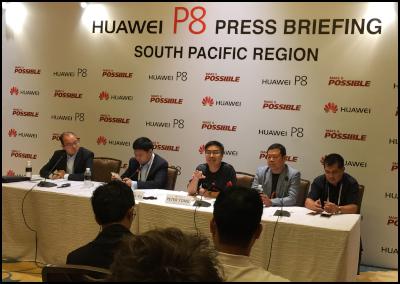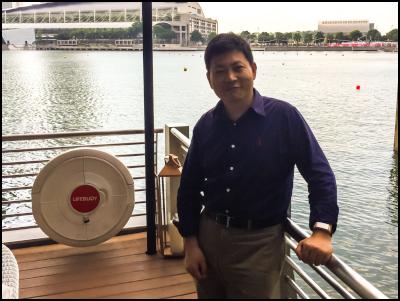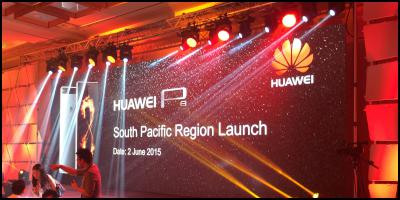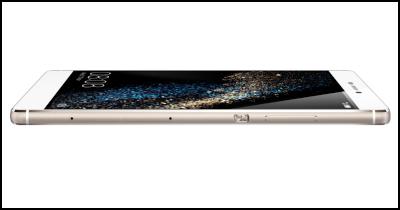
Phone makers are not modest by nature. Their product launches are often a mix of razzamatazz, extravagant claims and a laundry list of features.
Huawei’s P8 phone launch in Singapore on Wednesday had razzamatazz[1].
There was a long feature list. The Huawei P8 includes most things you’d expect to see in a 2015 flagship phone. Huawei emphasises the phone’s camera in its marketing[2]. Above all it takes great pictures in poor light conditions.
Instead of extravagant claims, Huawei Consumer
Business Group CEO Richard Yu used a post-launch press
conference to outline Huawei’s ambition.
Huawei aims to beat Samsung, challenge Apple
Yu wants his phone brand to go all the way. Huawei plans to zoom past Samsung and challenge Apple’s market leadership.
That’s impressive considering until 2011 Huawei’s phone business was mainly churning out low-cost mobile phones sold with a cell-phone carrier brand.
Yu says Huawei got into the smartphone business through the back door. The company is the largest maker of the network equipment used by mobile carriers.
When those carriers approached Huawei to find low-cost starter phones to get customers hooked on 3G data services, it obliged.

Huawei Consumer Business
Group CEO Richard Yu
Third largest smartphone brand
Five years ago the first Huawei branded models appeared. By last year it was the world’s third largest mobile phone brand behind Apple and Samsung.
Admittedly Huawei is still a fair way behind the leading brands, but innovative new phones like the P8 should help it close the gap.
Huawei is already ahead of well-known names like Nokia, Sony, BlackBerry, LG and HTC.
Yu says the short-term goal is for Huawei to move to second place. That means selling more phones than Samsung[3].
Last year The Wall Street Journal
reported Huawei’s market share was 6.9 percent. There’s
a lot of catching up to do. At the time Samsung was on 25
percent. But Huawei saw sales jump 95 percent in the second
quarter while Samsung sales dropped almost 4
percent.
Huawei keeps Samsung awake at nights
Huawei represents Samsung’s worst nightmare. The P8 directly challenges the Samsung Galaxy S6. Both flagship phones run Android.
During the formal launch Yu reeled off comparisons between features on the two phones. In each case Huawei offers more than Samsung. The two ranges are on a different release cycle, but at first sight Huawei’s flaghip phone is every bit as good as Samsung’s, possibly better.
At the time of writing Huawei has yet to announced the New Zealand price of the P8.
In Singapore, where the local dollar is on a par with
the NZ dollar, the phone costs S$700. In that country the
Samsung Galaxy S6 is S$1000. It’s likely the ratio between
the two prices will be similar in New
Zealand.
Sumsung’s weak spot
Price hits Samsung where it is most vulnerable. The Galaxy S6 phones are expensive in comparison. Huawei offers something that is at least as good for 30 percent less.
Samsung’s phone business barely breaks even, it has little room to move on price.
That leaves branding. Samsung remains a strong brand, especially among Android fans.
At the launch in Singapore and the press conferences after the launch there was talk of promotional campaigns that will boost Huawei’s profile in South-East Asia. We can expect similar here.
Within hours of the launch Huawei’s P8 advertising was noticeable on the Singapore metro system and at Changi Airport.

Marketing razzamatazz starts
here
Beyond marketing
Huawei’s trump card in the tussle with Samsung is its lead in cellular networks. Yu says: “Our infrastructure business means can can be the first to support new standards when they emerge. We know how to build phones that support the latest technologies. We can make them run at higher speeds and lower latency”.
Away from engineering, Huawei’s close relationship with carriers gives it an advantage. In New Zealand the company has either built or is building networks for Spark and 2degrees.
Yu says carrier relationships help
Huawei build better phones. They also help get phones into
customer’s hands.
Organic growth
He says Huawei plans to get to the market top spot purely on organic growth. While Yu says he expects most other smartphone brands to disappear in the next three to five years — “globally only three or four brands will survive” — he isn’t in a hurry to buy their assets.
Last year Huawei’s consumer division, that’s the part of the company making phones, had revenue of US$12.2 billion. The goal is to reach US$16 billion this year — Yu says Huawei is on target. He wants that number to reach US$50 billion in four years.

Huawei P8
phone
Yu’s audacious Huawei ambition
If Yu’s consumer division follows the growth plan he has mapped out, it will soon become the dominant part of Huawei.
That will change the nature of Huawei. Its core business, telecommunications network hardware, is now at saturation point. After years of expansion any future growth is likely to be sluggish in comparison.
Huawei also has an
enterprise information technology division. It’s still
small but the overall IT market dwarfs the
telecommunications network market. In 2013 the enterprise
division accounted for just US$1 billion of Huawei’s total
revenue of US$39 billion.
Huawei’s advantage
Huawei has an important advantage over its rivals in the network equipment, enterprise IT and smartphone markets. Unlike most other companies it is privately held, the shares are mainly owned by employees.
This means it doesn’t have to chase quarterly targets. Instead it can plan and invest for the long-term. At Huawei there’s a huge emphasis on research and development with up to 15 percent of revenues reinvested.
The company has already proved it knows how to focus on price, quality and customer service in the telecommunications hardware business. It has a patience and a maturity that’s rare in the flash-in-the-pan gadget world.
Huawei has already taken on and beaten the network
equipment makers. It has the confidence to go head-to-head
with the likes of Cisco, HP and IBM. In comparison tackling
Samsung to win the Android phone crown doesn’t seem over
ambitious.
- The event started with a sand artist work — or is that performance? — projected on a big screen. I’m not sure if it was Lawrence Koh, but this video gives a taste of the Huawei show. Also there was a river trip with a laser light show, flying coloured dragons and glow-in-the-dark dancers.
- You’ll can read more about that when I post my P8 phone review.
- We’ll shelve discussion of going past Apple for now although that is clearly somewhere in Huawei’s plan.
P8 phone highlights Huawei ambition



 Ian Powell: When Politics Gets In The Pocket Of The Gun Lobby
Ian Powell: When Politics Gets In The Pocket Of The Gun Lobby Binoy Kampmark: AUKUS - Flawed And Sinking
Binoy Kampmark: AUKUS - Flawed And Sinking Martin LeFevre - Meditations: The Darkest Hour Before Dawn Or The Sum Of All Dark Ages?
Martin LeFevre - Meditations: The Darkest Hour Before Dawn Or The Sum Of All Dark Ages? Gordon Campbell: On Justin Trudeau’s Demise, In A Global Context
Gordon Campbell: On Justin Trudeau’s Demise, In A Global Context Ramzy Baroud: Israel Destroyed Gaza ‘For Generations To Come’ And The World Stayed Silent
Ramzy Baroud: Israel Destroyed Gaza ‘For Generations To Come’ And The World Stayed Silent Binoy Kampmark: Detained Without Charge - Eleven Yemenis Leave Guantánamo
Binoy Kampmark: Detained Without Charge - Eleven Yemenis Leave Guantánamo